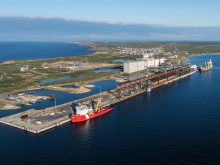International fertilizer prices are starting to fall.
This is good news because crop prices have taken a beating and for farming to remain a profitable enterprise, revenue and costs must not range too far apart.
The Market, a London-based fertilizer price newsletter found at www.FertilizerWorks.com, describes urea prices at the Gulf of Mexico and sulfur prices at Vancouver as “plunging.” Diammonium phosphate (DAP) basis Tampa, Florida, was “soft” and other nutrients in other locations are “sinking” or “weaker” although still high compared to a year ago.
Read Also

U.S. market can’t easily be replaced
The deputy chief economist of Farm Credit Canada says 92 per cent of Canada’s total exports to the U.S. went into the country duty-free in June.
Granular urea basis United States gulf ports was $450 to $500 US per short ton Oct. 9 compared to $505 to $540 Oct. 2 and $751 to $756 Sept. 4.
DAP at Tampa has declined much less. It was $950 to $1,015 per tonne Oct. 9 compared to $1,150 to $1,160 Sept. 4.
Sulfur at Vancouver was $180 to $350 per tonne, compared to $650 to $700 Sept. 4.
Yara International, the Norwegian company that recently bought Saskferco’s plant at Belle Plaine, Sask., publishes international fertilizer prices every Friday on its website www.yara.com. Click on “investor relations” and then “analyst information” to get to the prices.
It says that as of Oct. 16, bulk prilled urea basis the Black Sea fell to $340 per tonne compared to $803 at the beginning of September.
Phosphoric acid P2O5 basis North Africa had dropped to $1,943 compared to $2,268 at the beginning of September.
Potash prices have not fallen.
Fertilizer dealers are likely caught in a squeeze, having bought supplies in September when prices were much higher.
A factor in fertilizer demand is the mix in U.S. corn and soybean production. Corn requires more fertilizer than soybeans and next year there will be more corn and fewer soybeans.
Since booming ethanol and export demand for grain started a few years ago, the spring acreage struggles in the U.S. have seen wild swings between the two crops.
In 2007, corn area rose 15.3 million acres from the year before and soybeans fell 10.8 million. In 2008, corn fell 6.7 million and soybeans rose 12.3 million.
But Darrel Good, a University of Illinois extension marketing specialist, said the swing in 2009 might be less pronounced. See www.aces.uiuc.edu/news/weeklyoutlook.html.
Given the expected carry of corn and soybeans into 2009-10, Good believes the market will be well supplied, with a two to three million acre drop in U.S. soy acreage providing most of the space needed for a three to four million acre increase in corn. Reduced soft red winter wheat area could make up the difference.
Good said the implication is a reduced battle for acreage in 2009, but corn prices must be high enough in relation to soybeans to prompt the modest acreage shift.














